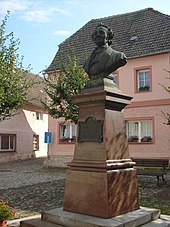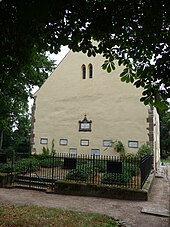Wiehe
|
Wiehe
City and rural community of Roßleben-Wiehe
|
|
|---|---|
| Coordinates: 51 ° 15 ′ 54 ″ N , 11 ° 24 ′ 45 ″ E | |
| Height : | 140 m |
| Area : | 24.52 km² |
| Residents : | 1871 (Dec. 31, 2017) |
| Population density : | 76 inhabitants / km² |
| Incorporation : | 1st January 2019 |
| Postal code : | 06571 |
| Area code : | 034672 |
Wiehe is a district of the city and rural community of Roßleben-Wiehe in the far east of the Thuringian Kyffhäuserkreis .
location
Wiehe is located in the valley of the Unstrut on the northern slope of the Hohe Schrecke , a wooded mountain ridge. The state roads 1215 and 1217 connect the city traffic as standard with the surrounding areas of Saxony-Anhalt and Thuringia.
history
At the beginning of the 9th century Wiehe is mentioned for the first time in a list of the goods of the Hersfeld Monastery built by Archbishop Lullus († 786) of Mainz . A monastery in Wiehe is mentioned in a document from King Heinrich I dated June 1, 933. The document that has come down to us is a 12th century production, but seems to be a good copy of a real diploma from King Henry, which has not been passed down. Wiehe became an imperial castle under King Heinrich I and came to the Memleben monastery in 998. The viticulture in Wiehegau was documented for the first time in the deed of gift. The county of Wiehe comprised the city of Wiehe and twenty villages, as well as three castles (Rabenswalde, Wendelstein, Bucha) and three monasteries (Donndorf, Hechendorf, Memleben). For a short time they also had the right to mint, as proven by coin finds. The Counts of Rabenswald -Wiehe were lords of Wiehe from 1227 to 1312. In 1233/37 the Rabenswalde Castle was built under the Count of Rabenswalde . Wiehe itself was also fortified and had already had important magistrate rights since 1320. After changing owners, the Counts of Weimar (Orlamünde) in 1312, the Thuringian Landgraves in 1346, the Duke of Braunschweig in 1367, the Noble Lords of Querfurt in 1369, the Lords of Heldrungen in 1412, the Count of Hohnstein in 1413, the Count of Beichlingen-Wiehe in 1415 , again the nobles of Querfurt in 1436, then Apel Vitzthum in 1446, the Counts of Schwarzburg in 1447, Wiehe came to the von Werthern-Wiehe family in 1461 . After a major fire in 1659 that destroyed the town, church and castle, Wiehe was rebuilt. A knightly family of the same name named themselves after the place, the von Wiehe , which is documented from 1231 to 1629.
Already at the beginning of the Nazi era , which began with the persecution of socialists and communists , a resistance group called Tras was formed , which included local residents. During the Second World War , at least 50 prisoners of war from Poland and France as well as women from Poland had to do forced labor : on the Werthern manor , in the machine factory W.Bosek and on the Pforta'ischer school property in Hechendorf . In April 1945 a train of prisoners from the Dora-Mittelbau concentration camp dragged its way through the town.
From 1976 until the reunification in 1990 Wiehe was part of the Unstruttal community association with Roßleben, Langenroda and Donndorf.
On January 1, 2019, the towns of Wiehe and Roßleben and the communities of Donndorf and Nausitz merged to form the new town and rural community of Roßleben-Wiehe . Wiehe was a fulfilling community for Donndorf.
The districts of Langenroda , Garnbach and Hechendorf belonged to the city of Wiehe .
Incorporations
As early as July 1, 1950, the previously independent municipality of Garnbach was incorporated. Langenroda followed on March 25, 1994.
Population development
Development of the population (December 31) :
|
|
|
|
- Data source: Thuringian State Office for Statistics
politics
City council
After the local elections on May 25, 2014, with a turnout of 50.2%, the city council of Wiehe was composed as follows:
mayor
- 1945: Hugo Launicke ( KPD )
- 1990-2006: Wilhelm Willomitzer
- 2006–2018: Dagmar Dittmer (CDU), confirmed in office on April 22, 2012 with a turnout of 52.2% with 97.7% of the valid votes
coat of arms
Blazon : “In silver a nimbly saint in a blue cloak, in his right hand a raised silver knife. holding a staff in his left hand; a black shield at his feet, inside a golden branch with three golden maple leaves, placed at an angle. "
The coat of arms shows St. Bartholomew, the patron saint of the town church in Wiehe, with his attributes. The shield shows the family coat of arms of the Lords of Werthern , who were initially resale from 1453 and hereditary from 1461 in the repeatedly divided Grafschaft Wiehe. The shield first appeared in the middle of the 16th century on a seal with the inscription: SIGILLVM CIVITATIS WIHE. On earlier seals, Bartholomew can be seen alone under a canopy.
Attractions
- St. Bartholomew Church : Protestant town church. It probably stands on the foundations of a church mentioned in 933. The current church is the fourth and dates from 1670. It has valuable fittings . Underneath are an offering box that is said to have come from the first church, memorial plaques and the burial place of the Werthern patron, a wooden figure of Christ from around 1500 and the tomb "Idol Chamber". Memorial plaques on the outside of the church facing the market list the names of the fallen and missing soldiers from both world wars from Wiehe.
- St. Ursula Church : The church was built before 1250 and burned down almost completely in 1659. The current church was built between 1742 and 1750. From 1996 to 2003 the interior and exterior of the church were completely renovated. Today it serves as a cemetery church and since 2009 as a cycle path church .
- Old cemetery : It surrounds the Ursula Church and was consecrated in 1659. The cemetery contains a large number of graves of important personalities of the city and - on the gable side of the church - the family grave of those von Werthern (from 1834 to 1941). Commemorative plaques are also attached to the last owner of the Wiehe castle and manor and his wife, who died in West Germany. Since 2003, burials have been possible again in the "Old Cemetery".
- The Langenroda post mill ( 51 ° 17 ′ 4.1 ″ N , 11 ° 23 ′ 4.5 ″ E ) is one of the few surviving windmills in Thuringia and was built in 1732 in the open field near the district of Langenroda. The German Foundation for Monument Protection and an association of committed mill friends helped the owners to rebuild this already badly dilapidated mill. A specialist company managed the complex technical restoration of the mill. The mill has been operational again since 2001.
- Old School (built in 1827; now houses a local museum, city library and occasional local art exhibitions)
- Rabenswalde castle ruins
- Wiehe Castle with Castle Park and Castle Pond
- Modellbahn-Wiehe (world's largest year-round model railway show)
- Tourist center "Stadtpark Wiehe"
- Rank monument (maintained by the rank association)
societies
- Friends of the St. Bartholomew and St. Ursula Church in Wiehe e. V.
- Ranke-Verein Wiehe e. V.
- Wiehescher Carneval Club e. V.
- Fire Brigade Association Wiehe e. V.
- Schalmeienkapelle Rot-Weiß Wiehe e. V.
Personalities
The family of scholars Ranke comes from Wiehe, the most famous representative of which is the historian Leopold von Ranke .
sons and daughters of the town
- Dietrich von Werthern (1468–1536), Chancellor of the German Order and councilor to Duke George of Saxony
- Anton Musa (around 1485–1547), Protestant theologian and reformer
- Karl Ernst Christoph Schneider (1786–1856), classical philologist
- Leopold von Ranke (1795–1886), historian
- Friedrich Heinrich Ranke (1798–1876), Protestant theologian
- Karl Ferdinand Ranke (1802–1876), classical philologist and high school teacher
- Ernst Ranke (1814–1888), Protestant theologian
Leopold von Ranke
Wiehe's greatest son is the historian Leopold von Ranke , the founder of modern history. Several memorial sites in the village refer to him. The Ranke monument, inaugurated in 1896, stands next to the town hall. Ranke's children erected an obelisk for their ancestors on the Rankegraben outside the city. Ranke's birthplace, in the street named after him in 1990, was restored by local craftsmen in 1995/96 on the occasion of his 200th birthday and is provided with a memorial plaque.
The Ranke Association , which was founded in 1993, set up a small museum for him in the town hall in 1994 . It again contains a collection of works, letters and other writings, as well as loans from local residents and gifts from Ranke's descendants. A Ranke Museum had already been opened in 1906 in the birthplace, moved to the town hall around 1930 and was closed in May 1945. There was looting in 1945, in 1952 the boxes with the remaining inventory were removed and the museum's holdings were completely lost.
Others
- The Unstrut cycle path runs 5 km north of Wiehe and is connected to the city by a cycle path.
- Wiehe is a member of the Saale-Unstrut-Triasland Geo-Nature Park .
Web links
Individual evidence
- ↑ Document book of the Reichsabtei Hersfeld edited by Hans Weirich, first volume, Marburg 1936, pp. 83–85.
- ↑ cf. JF Hoffmann: Historical news of the Wiehe rule , 1755
- ↑ Thuringian Association of the Persecuted of the Nazi Regime - Association of Antifascists and Study Group of German Resistance 1933–1945 (Ed.): Heimatgeschichtlicher Wegweiser to places of resistance and persecution 1933–1945, series: Heimatgeschichtliche Wegweiser Volume 8 Thüringen, Erfurt 2003, ISBN 3- 88864-343-0
- ↑ Federal Statistical Office (Ed.): Municipalities 1994 and their changes since 01.01.1948 in the new federal states . Metzler-Poeschel, Stuttgart 1995, ISBN 3-8246-0321-7 .
- ↑ 2014 municipal council election in Thuringia - final result for Wiehe
- ^ New Thuringian Wappenbuch Volume 2, page 32; Publisher: Arbeitsgemeinschaft Thüringen e. V. 1998 ISBN 3-9804487-2-X
- ^ "Langenroda" . In: Sparkassen-Kulturstiftung Hessen-Thüringen (Hrsg.): Cultural discoveries. Eichsfeld district, Kyffhäuserkreis, Nordhausen district, Unstrut-Hainich district . tape 1 (Thuringia). Schnell & Steiner, Regensburg 2009, ISBN 978-3-7954-2249-3 , pp. 234-237 .
- ^ Woldemar Lippert : Werthern, Dietrich von . In: Allgemeine Deutsche Biographie (ADB). Volume 42, Duncker & Humblot, Leipzig 1897, pp. 116-122.






